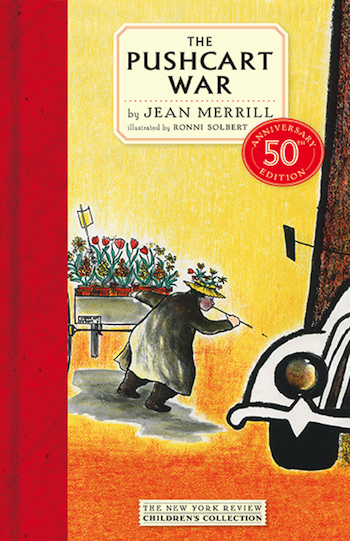Book Review: “The Pushcart War” — One for the 99%
First published in 1964, Jean Merrill’s classic children’s novel has just been reissued by New York Review Books to celebrate its 50th anniversary.
The Pushcart War, by Jean Merrill. Illustrated by Ronni Solbert. First published, W.R. Scott, 1964. Republished, New York Review Books, 2014. 232 pages, $15.95.

By Patrice Sherman
In the November 3, 2014 issue of the New Yorker, journalist Nick Paumgarten sums up current efforts to decrease the number of vehicles in New York City as “our latter day version of the ‘Pushcart War’…”
Having recently reread The Pushcart War myself, I was delighted to find it cited in an article on contemporary traffic woes. First published in 1964, Jean Merrill’s classic children’s novel has just been reissued by the New York Review Books to celebrate its 50th anniversary. Not every classic, however, remains fresh from generation to generation. Inevitably the new edition prompts the question: Does The Pushcart War, beloved as it may be, still have something to say in today’s world?
Merrill claimed she wrote the book because she was tormented by the incessant rumbling of large trucks through Greenwich Village when she lived there during the early 1960s. Already a successful children’s author, she adroitly transformed her irritation into a whimsical tale about a valiant band of pushcart operators who, armed with nothing more than peashooters and the power of public opinion, stand up to the big-wheeled behemoths and reclaim the city streets.
Merrill wasn’t the only one concerned with the quality of urban life at that time. At the very moment she was penning her story of little guys beating big guys at their own game, urban historian Jane Jacobs was busy organizing a committee to protest powerful city planner Robert Moses’ desire to construct an expressway straight through Washington Square Park, demolishing the park and large chunks of the neighborhood in its wake. While the proposed expressway would no doubt be wonderful for trucks, it would be disastrous for people.
Jacobs had first come to national attention in 1961 with the publication of her opus, The Death and Life of Great American Cities. Despite its somber title, the book is filled with paeans to what she calls, “the ballet of street life,”—the ceaseless parade of pedestrians, children at play, and, of course, pushcarts that she observed from her front stoop every day. Both Merrill and Jacobs lived in the Village, and though there’s no record they ever met, it’s nice to think they might have occasionally passed one another or even stopped at the same cart for a pretzel or a bunch of daffodils.
Certainly Morris the Florist, Frank the Flower, Harry the Hot Dog, Mr. Jerusalem the Scrap Metal Man, Papa Perez (2 Pretzels 25¢), and Merrill’s other fictitious pushcart operators would have beamed with approval upon Jacobs’ corps of community activists as they confronted the man who was possibly the most formidable city mayor in the entire nation. This real-life parallel to The Pushcart War was truly epic in scope, lasting nearly a decade and coming to an end only when Moses agreed to permanently close Washington Square to traffic in 1968.

An illustration from “The Pushcart War.”
The Pushcart War, the novel, is mercifully much shorter. Chronologically, the action transpires over the course of a few months and encompasses a mere 222 pages. Instead of Jacobs at the helm, it is General Anna the apple seller who leads her pushcart army on a massive Peace March through lower Manhattan, stopping trucks dead in their tracks.
In both stories, the 99% manage to rout the 1%, whether that 1% consists of affluent officials or eight-wheeled Mighty Mammoths. And in both cases, too, the battles may be won, but the wars are never quite over. Urban planning remains perennially contentious in New York. Nor are pushcarts safe. According to the Nov. 5 edition of the New York Times, the Metropolitan Museum is now trying to evict the various food and beverage carts that cluster at the foot of its front steps. It should be noted that in the beginning of The Pushcart War, Anna is introduced as “Old Anna,” a peddler of “apples and pears of the highest quality outside…museums.” Only when this sweet little old lady’s livelihood is threatened does she morph into “General Anna,” a Jacobs-like figure of fierce determination and iron will.
The Pushcart War lives on. Perhaps in trying to rid itself of a few hot dog and pretzel vendors the mighty Met is biting off more than it can chew.
Pat Sherman is the author of several books for children and young adults, including Ben and the Emancipation Proclamation, winner of the 2011 Once Upon a World Award from the Wiesenthal Center in LA. You can find out more about her and her writing here.
Tagged: Jean Merrill, New York Review Books, Patrice Sherman, Ronni Solbert, The New York Review's Children's Collection
